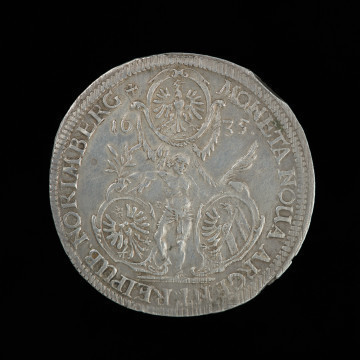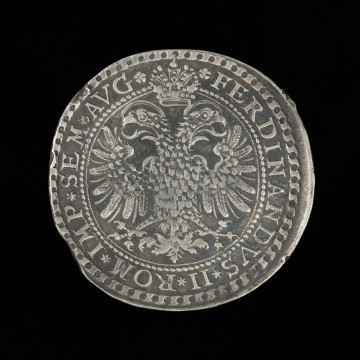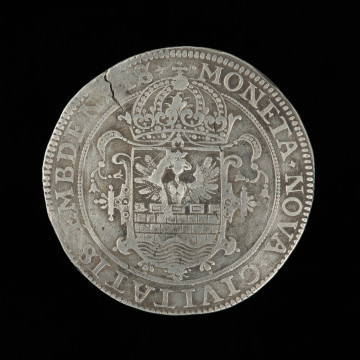
Thaler of the Reich
1624
National Museum in Szczecin
Part of the collection: German coins
There were three types of cities with special status within the German Reich. These included the imperial cities, ruled directly by the emperor, free cities in which local dukes had some power, and the so-called burghers’ cities, which enjoyed some independence, while being controlled by a secular or clerical magnate. As wealth increased, cities sought to free themselves from their sovereigns. The bishopric of Hildesheim was one of these cities. In 1528 the town council requested Emperor Charles V Habsburg (1500-1558) to give the city its own coat of arms and to remove Hildesheim from under the episcopal authority. The Emperor granted this request, but only partially. This can be seen on the reverse of the presented thaler. The field of the reverse is filled with a coat of arms consisting of a shield and a helmet with mantling and a crest, attributes typical of knightly heraldry. The crest is a half-figure of a virgin – according to tradition, she was known as Hildesia. Here she can be seen holding a garland of rose flowers in her hands. The garland refers to the “thousand-year-old rose bush” that grows in the apse of Hildesheim Cathedral. The oval shield visible in the lower part of the coat of arms was divided into two fields. The upper one features a half eagle, which was supposed to denote the imperial eagle, and the lower one features a chequered field. Thus, the old coat of arms of the diocese of Hildesheim was incorporated into the shield of the new coat of arms, with the insignia of the religious authorities removed. The imperial privilege specified the colours of the coat of arms, which are dominated by the traditional colours of the bishops of Hildesheim. This striking coat of arms thus accentuates the city’s dependence on the bishop and is a clear attempt to compromise between the aspirations of the burghers, and the emperor's loyalty to the Church. Although Hildesheim was not elevated to the status of an imperial city and in fact remained dependent on the bishop, it strengthened its status as a semi-autonomous urban republic. This is also highlighted by the Latin inscription on the thaler: New Coin of the Republic of Hildesheim.
Mieszko Pawłowski
Other names
Reichstaler
Author / creator
Dimensions
cały obiekt:
Object type
coin, money
Technique
minting
Material
silver
Creation time / dating
Creation / finding place
Owner
National Museum in Szczecin
Identification number
Location / status

1624
National Museum in Szczecin

1624
National Museum in Szczecin

1619 — 1637
National Museum in Szczecin
DISCOVER this TOPIC
Museum of King Jan III's Palace at Wilanów
DISCOVER this PATH
Educational path